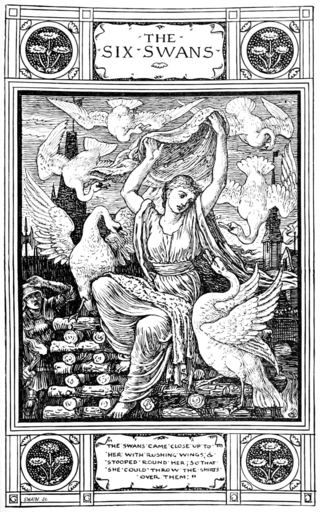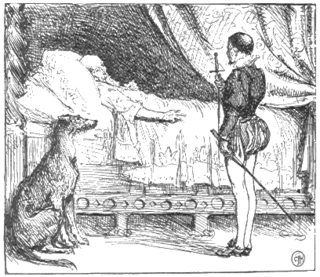The Raven is an Italian literary fairy tale written by Giambattista Basile in his 1634 work, the Pentamerone . [1] The story is a man winning a bride for his brother the king, and then having to protect the couple from perils that he can not tell anyone about, without being turned to stone.
It is Aarne-Thompson type 516. [2] Others of this type are Trusty John , [3] and Father Roquelaure . [2] It is an unusual variant, in that most tales feature the main character as a servant rather than a brother. [4]
A king named Milluccio once saw a dead raven on stone, and fell in love with the thought of a wife as black as the raven, as red as its blood, and as white as the stone. It affected his health until his brother Jennariello asked what was wrong with him and finally learned the story. Jennariello set out by ship. He bought a falcon and a splendid horse, and a beggar persuaded him to tell his story. The beggar then begged at a magician's house, and Jennariello saw that the magician's daughter, Liviella, matched his brother's dream exactly. Jennariello dressed as a peddler and showed Liviella hoods, handkerchiefs, and other goods, and persuaded her to come to the ship to see his better wares. Then he sailed off with her. Liviella lamented, but Jennariello told her why, and described his brother to her so vividly that she wanted to see this man.
On the voyages, two doves flew up. They talked, and one told the other that the falcon would pick out Milluccio's eyes the first time it saw him, but if Jennariello warned him, or did not bring him the bird, Jennariello would turn to marble; that the horse would break Milluccio's neck the first time he rode it, but if Jennariello warned him, or did not bring him the horse, he would turn to marble; and that a dragon would eat Milluccio and Liviella on their wedding night, but if Jennariello warned him, or did not bring him Liviella, Jennariello would turn to stone.
Jennariello brought his brother the horse and the falcon and then instantly killed them. At the wedding night, Jennariello went with a sword and fought the dragon, but when his brother woke, the dragon vanished, and he had Jennariello imprisoned as a traitor that night and sentenced to die the next. Wishing to die known as innocent, he told Milluccio his story, and turned to stone.
Liviella had twin sons. One day, while she was gone, an old man asked Milluccio what he would give to restore his brother. Milluccio said his kingdom, and when told life was needed, offered his own; when the old man said his sons' lives were needed, he killed them and put the blood on the statue, which restored Jennariello. Liviella returned and was grief-stricken, and went to the window to throw herself out. The old man, her father, stopped her, and told her that he had punished them all for their acts against him, but the punishment had been enough. He restored the babies to life.

Giambattista Basile was an Italian poet, courtier, and fairy tale collector. His collections include the oldest recorded forms of many well-known European fairy tales. He is chiefly remembered for writing the collection of Neapolitan fairy tales known as Il Pentamerone.

The Pentamerone, subtitled Lo cunto de li cunti, is a seventeenth-century Neapolitan fairy tale collection by Italian poet and courtier Giambattista Basile.

"The Six Swans" is a German fairy tale collected by the Brothers Grimm in Grimm's Fairy Tales in 1812. It is of Aarne–Thompson type 451, commonly found throughout Europe. Other tales of this type include The Seven Ravens, The Twelve Wild Ducks, Udea and her Seven Brothers, The Wild Swans, and The Twelve Brothers. Andrew Lang included a variant of the tale in The Yellow Fairy Book.
Farmer Weathersky is a Norwegian fairy tale collected by Peter Chr. Asbjørnsen and Jørgen Moe in Norske Folkeeventyr.

"Petrosinella" is a Neapolitan literary fairy tale, written by Giambattista Basile in his collection of fairy tales in 1634, Lo cunto de li cunti, or Pentamerone.

"Trusty John", "Faithful John", "Faithful Johannes", or "John the True" is a German fairy tale collected by the Brothers Grimm and published in Grimm's Fairy Tales in 1819. Andrew Lang included it in The Blue Fairy Book.
In Love with a Statue is an Italian fairy tale collected by Thomas Frederick Crane in his 1885 book Italian Popular Tales.
Cannetella is a Neapolitan literary fairy tale told by Giambattista Basile in his 1634 work, the Pentamerone. Andrew Lang included it in The Grey Fairy Book, as collected by Hermann Kletke.
The Goat-faced Girl is an Italian fairy tale. Giambattista Basile included a version in his Pentamerone (1634-1636). Andrew Lang included a version, collected by Hermann Kletke, in The Grey Fairy Book (1900).
The Flea is an Italian literary fairy tale written by Giambattista Basile in his 1634 work, the Pentamerone. It combines Aarne-Thompson-Uther types 857, "The Louse-Skin" and ATU 653, "The Four Skillful Brothers".
Penta of the Chopped-off Hands or The Girl With the Maimed Hands is an Italian literary fairy tale written by Giambattista Basile in his 1634 work, the Pentamerone.
Sapia Liccarda is an Italian literary fairy tale written by Giambattista Basile in his 1634 work, the Pentamerone. It is not known whether he had a specific source, either literary or oral, for this tale.
The Enchanted Snake or The Snake is an Italian fairy tale. Giambattista Basile wrote a variant in the Pentamerone. Andrew Lang drew upon this variant, for inclusion in The Green Fairy Book.
The Three Enchanted Princes or The Three Animal Kings is an Italian literary fairy tale written by Giambattista Basile in his 1634 work, the Pentamerone. It is Aarne–Thompson–Uther Index ATU 552, "The Girls who married animals". At the end of the tale, the prince's brothers-in-law help him in defeating the dragon.
The Merchant is an Italian literary fairy tale written by Giambattista Basile in his 1634 work, the Pentamerone.
The Dove is an Italian literary fairy tale written by Giambattista Basile in his 1634 work, the Pentamerone.
"Corvetto" is an Italian literary fairy tale written by Giambattista Basile in his 1634 work, the "Pentamerone".
Father Roquelaure is a French fairy tale collected by Achille Millien.
The Three Crowns is an Italian literary fairy tale written by Giambattista Basile in his 1634 work, the Pentamerone.
The Dragon is an Italian literary fairy tale, included in Giambattista Basile's Pentamerone, first published 1635. In the English language, the tale was a selection in Thomas Keightley's Fairy Mythology (1828), and later appeared in John Edward Taylor 's translation of the entire work, The Pentamerone, or, The Story of Stories, Fun for the Little Ones (1848). The tale has been classed as a version of Aarne–Thompson type 462 "the outcast queens and the ogress queen", rather than as "the dragon-slayer". It exhibits folklore motif K873, "fatal deception by giving narcotic."